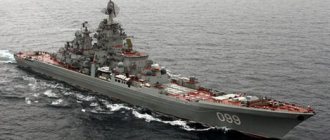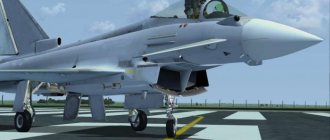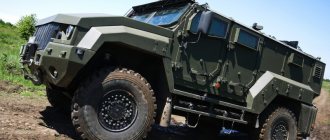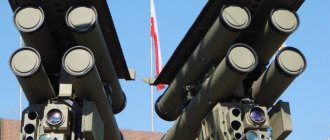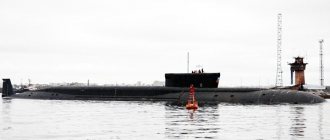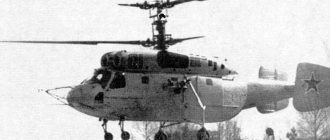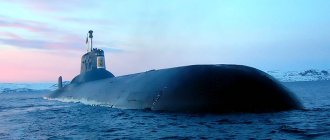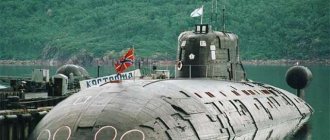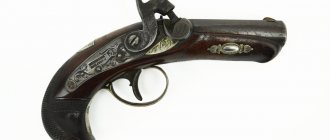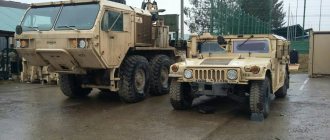Project 941 Akula submarines - video
The tactical and technical specifications for the design were issued in December 1972, and S. N. Kovalev was appointed chief designer of the project. The new type of submarine cruiser was positioned as a response to the US construction of Ohio-class SSBNs (the first boats of both projects were laid down almost simultaneously in 1976). The dimensions of the new ship were determined by the dimensions of the new solid-fuel three-stage intercontinental ballistic missiles R-39 (RSM-52), with which it was planned to arm the boat. Compared to the Trident-I missiles, which were equipped with the American Ohio, the R-39 missile had better flight range characteristics, throw weight and had 10 blocks versus 8 for the Trident. However, the R-39 turned out to be almost twice as long and three times as heavy as its American counterpart. The standard SSBN layout was not suitable for accommodating such large missiles. On December 19, 1973, the government decided to begin work on the design and construction of a new generation of strategic missile carriers.
The first boat of this type, TK-208 (which means “heavy cruiser”), was laid down at the Sevmash enterprise in June 1976, launched on September 23, 1980. Before the descent, an image of a shark was painted on the side of the submarine in the bow below the waterline; later, stripes with a shark appeared on the crew’s uniform. Despite the later launch of the project, the lead cruiser entered sea trials a month earlier than the American Ohio (July 4, 1981). TK-208 entered service on December 12, 1981. In total, from 1981 to 1989, 6 Akula-type boats were launched and put into operation. The planned seventh ship was never laid down; Hull structures were prepared for it.
The construction of “9-story” submarines provided orders for more than 1000 enterprises of the Soviet Union. At Sevmash alone, 1,219 people who participated in the creation of this unique ship received government awards. For the first time, Leonid Brezhnev announced the creation of the “Shark” series at the XXVI Congress of the CPSU.
To ensure reloading of missiles and torpedoes, in 1986 the diesel-electric transport-missile carrier “Alexander Brykin” of Project 11570 was built with a total displacement of 16,000 tons; it could carry up to 16 SLBMs.
In 1987, the TK-12 "Simbirsk" carried out a long high-latitude voyage to the Arctic with repeated replacement of crews.
On September 27, 1991, during a training launch in the White Sea on the TK-17 Arkhangelsk, a training rocket exploded and burned out in the silo. The explosion tore off the cover of the mine, and the warhead of the rocket was thrown into the sea. The crew was not injured during the incident; the boat was forced to undergo minor repairs.
In 1998, tests were carried out in the Northern Fleet, during which 20 R-39 missiles were launched “simultaneously”.
Alternate fate
If the decision to stop further use of the Sharks as part of the nuclear deterrence policy looks logical, it remains unclear why the military still intends to dispose of these ships. For example, in 2002, the United States decided to reduce the number of Ohio-class strategic submarines, but did not plan to decommission the Navy ships. In September 2002, the US Navy command signed a contract with Electric Boat worth $442.9 million, under which the American company was to implement the first stage of converting four Ohio submarines from Trident ballistic missile carriers to Tomahawk cruise missile carriers.
The conversion program was additionally funded in 2002-2006, and the total cost of its implementation amounted to $3.2 billion. The conversion of each submarine, which made it possible to equip the Ohio with 154 Tomahawk cruise missiles, cost the US military budget $800 million. The program was subsequently deemed costly and closed. The US Navy currently operates 18 Ohio-class submarines; 14 of them are carriers of ballistic missiles. As part of START-3, the United States intends to replace all 14 “nuclear” Ohio submarines with advanced SSBN(X) submarines by 2040. Ships will be decommissioned naturally as their service life expires.
Theoretically, the Russian Ministry of Defense could convert the decommissioned Sharks, following the example of the American Ohio submarines, making them carriers of either cruise missiles or other types of weapons ─ the large size of the ships allows the most daring ideas to be realized. In addition, submarines could be used for research purposes or for covert transportation of military personnel or cargo. However, the Ministry of Defense is not working on such plans. According to the military department, any re-equipment of submarines will require investments of tens of billions of rubles. In conditions of a significantly limited military budget, these expenses seem unnecessary.
| Ohio-class nuclear submarine. Photo from website navy.mil |
The Russian State Armaments Program for 2011-2020 implies funding in the amount of 20 trillion rubles. It will make it possible to implement several development programs, as well as update the fleet of military equipment of the Armed Forces by 75 percent. The military themselves previously stated that these funds would not be enough to completely modernize the Armed Forces. Thus, in September 2010, the acting head of armaments of the Russian Ministry of Defense, Lieutenant General Oleg Frolov, stated that in order to sufficiently finance all branches of the country's troops, the amount of funding for the state armament program should be at least 36 trillion rubles. At the same time, he noted that all branches of the military will be able to receive the funds in full, except for the Navy and the space group.
Moreover, even long-term storage and maintenance of Akula submarines afloat also requires certain financial investments. On the other hand, after decommissioning, the missile carriers could serve in the civilian fleet. In particular, earlier the Rubin Central Design Bureau, the developer of the Sharks, proposed using Project 941 submarines to transport commercial cargo, including oil, gas or ore, but subsequently abandoned this idea, recognizing it as inappropriate. Was involved in a project to transport ore under the Arctic ice
Apparently, this project would also be quite expensive, since when converting the submarine it would be necessary to remove all strategically important equipment, as well as redo the missile compartments
Finally, from the point of view of an ordinary, non-military person, at least one “Shark” could be preserved as a museum, as a monument to evidence of the engineering thought of a no longer existing state that is fading into oblivion. But this undertaking will require significant expenses and hassle. In particular, in this case, it will be necessary to dismantle and decontaminate the compartments with the nuclear reactor - a painstaking and extremely complex process. When dismantling submarines, this problem is solved more simply: by removing spent and irradiated nuclear fuel, cutting out a compartment from the hull, welding it and further long-term storage. In the case of organizing a museum, the hull of the nuclear submarine must remain intact.
In a word, apparently, having weighed all possible options, the Ministry of Defense decided that the disposal of submarines would cost the budget less than the implementation of alternative options for the fate of the Sharks. And here, maybe, foreigners will also help with money, as happened with the TK-202 and some other nuclear submarines.
Design of Project 941 Akula submarines
The power plant is made in the form of two independent echelons located in different durable buildings. The reactors are equipped with an automatic shutdown system in case of loss of power supply and pulse equipment for monitoring the condition of the reactors. When designing, the TTZ included a clause on the need to ensure a safe radius; for this purpose, methods for calculating the dynamic strength of complex hull components (fastening modules, pop-up cameras and containers, inter-hull connections) were developed and tested by experiments in experimental compartments.
To build the Sharks, a new workshop No. 55 was specially built at Sevmash - the largest indoor boathouse in the world. The ships have a large reserve of buoyancy - more than 40%. When submerged, exactly half of the displacement is accounted for by ballast water, for which the boats received the unofficial name “water carrier” in the navy, and in the competing design bureau “Malachite” - “a victory of technology over common sense.” One of the reasons for this decision was the requirement for the developers to ensure the smallest draft of the ship to be able to use existing piers and repair bases. Also, it is the large reserve of buoyancy, coupled with a durable deckhouse, that allows the boat to break through ice up to 2.5 meters thick, which for the first time made it possible to conduct combat duty in high latitudes right up to the North Pole.
Frame
A special feature of the boat’s design is the presence of five habitable durable hulls inside the light hull. Two of them are the main ones, have a maximum diameter of 10 m and are located parallel to each other, according to the principle of a catamaran. At the front of the ship, between the main pressure hulls, are missile silos, which were first placed forward of the wheelhouse. In addition, there are three separate pressurized compartments: a torpedo compartment, a control module compartment with a central control post, and an aft mechanical compartment. The removal and placement of three compartments into the space between the main hulls made it possible to increase the fire safety and survivability of the boat.
Both main strong hulls are connected to each other by three transitions through intermediate strong capsule compartments: in the bow, in the center and in the stern. The total number of waterproof compartments of the boat is 19. Two pop-up rescue chambers, designed for the entire crew, are located at the base of the wheelhouse under the retractable device fence.
The durable hulls are made of titanium alloys, the lightweight ones are made of steel, covered with a non-resonant anti-location and sound-insulating rubber coating with a total weight of 800 tons. According to American experts, the strong hulls of the boat are also equipped with sound-insulating coatings. The ship received a developed cruciform stern tail with horizontal rudders located directly behind the propellers. The front horizontal rudders are retractable.
In order for the boats to be able to carry out duty in high latitudes, the wheelhouse fencing is made very strong, capable of breaking through ice 2-2.5 m thick (in winter, the thickness of the ice in the Arctic Ocean varies from 1.2 to 2 m, and in some places reaches 2.5 m). The bottom surface of the ice is covered with growths in the form of icicles or stalactites of considerable size. When surfacing, the underwater cruiser, having removed the bow rudders, is slowly pressed against the ice ceiling with a specially adapted bow and wheelhouse fencing, after which the main ballast tanks are sharply purged.
Power point
The main nuclear power plant is designed according to the block principle and includes two water-cooled thermal neutron reactors OK-650 with a thermal power of 190 MW each and a shaft power of 2 × 50,000 liters. pp., as well as two steam turbine units, located one each in both durable hulls, which significantly increases the survivability of the boat. The use of a two-stage rubber-cord pneumatic shock absorption system and a block arrangement of mechanisms and equipment made it possible to significantly improve the vibration isolation of the units and, thereby, reduce the noise of the boat.
Two low-speed, low-noise, seven-bladed fixed-pitch propellers are used as propulsors. To reduce noise levels, the propellers are installed in ring fairings (fenestrons). The boat has backup propulsion means: two 190 kW DC electric motors. For maneuvering in cramped conditions, there is a thruster in the form of two folding columns with 750 kW electric motors and rotary propellers. Thrusters are located in the bow and stern of the ship.
Habitability
The crew is accommodated in conditions of increased comfort. The boat has a lounge for relaxation, a gym, a swimming pool measuring 4x2 m and a depth of 2 m, filled with fresh or salt sea water with the possibility of heating, a solarium, a sauna lined with oak boards, and a “living corner”. The rank and file are accommodated in small cockpits, the command personnel are accommodated in two- and four-berth cabins with washbasins, televisions and air conditioning. There are two wardrooms: one for officers, the other for midshipmen and sailors. Sailors call Akula-class submarines “the floating Hilton.”
Regeneration of the environment
In 1984, for participation in the creation of TRPKSN pr. 941 "Typhoon", the FSUE "Special Design and Technological Bureau for Electrochemistry with a Pilot Plant" (until 1969 - the Moscow Electrolysis Plant) was awarded the Order of the Red Banner of Labor.
laid up
Over the entire period of construction of Type 941 submarines, six cruisers were adopted by the Navy:
- “Dmitry Donskoy” (TK – 208). Adopted in December 1981, after modernization it began service again in July 2002.
- TK-202. Received home port and entered service in December 1983. In 2005, the boat was cut into scrap metal.
- "Simbirsk" (TK-12). Admitted to the Northern Fleet in January 1985. Was disposed of in 2005.
- TK-13. The cruiser was commissioned in December 1985. In 2009, the hull was cut into metal, and part of the submarine (six-compartment block, reactors) was transferred to long-term storage on the Kola Peninsula.
- "Arkhangelsk" (TK-17). Date of entry into the fleet - November 1987. Due to the lack of ammunition, the issue of disposal has been discussed since 2006.
- "Severstal" (TK-20). Enlisted in the Navy in September 1989. In 2004, it went into reserve due to lack of ammunition and is planned for disposal.
- TK-210. The laying of the hull structures coincided with the breakdown of the economic system. Lost funding and was dismantled in 1990.
The Akula class nuclear submarines were consolidated into one division, with Zapadnaya Litsa (Murmansk region) serving as their base. The reconstruction of Nerpichya Bay was completed in 1981. To accommodate type 941 cruisers, a mooring line and piers with special capabilities were equipped, and a unique crane with a lifting capacity of 125 tons was built for loading missiles (not put into operation).
Armament of Project 941 Akula submarines
The main armament is the D-19 missile system with 20 R-39 Variant three-stage solid-fuel ballistic missiles. These missiles have the largest launch weight (together with the launch container - 90 tons) and length (17.1 m) of the SLBMs put into service. The combat range of the missiles is 8300 km, the warhead is multiplex: 10 warheads with individual guidance of 100 kilotons of TNT each.
Due to the large dimensions of the R-39, the Akula project boats were the only carriers of these missiles. The design of the D-19 missile system was tested on the BS-153 diesel submarine, specially converted according to Project 619, which was based in Sevastopol, but it could only accommodate one silo for the R-39 and was limited to seven launches of dummy models. The entire ammunition load of the Akula missiles can be launched in one salvo with a short interval between the launch of individual missiles.
Launch is possible both from surface and submerged positions at depths of up to 55 m and without restrictions on weather conditions. Thanks to the ARSS shock-absorbing rocket launch system, the rocket is launched from a dry shaft using a powder pressure accumulator, which reduces the interval between launches and the level of pre-launch noise. One of the features of the complex is that with the help of the ARSS, the missiles are suspended at the neck of the silo. The design included the deployment of an ammunition load of 24 missiles, but, by the decision of the Commander-in-Chief of the USSR Navy, Admiral S.G. Gorshkov, their number was reduced to 20.
In 1986, a government decree was adopted on the development of an improved version of the missile - the R-39UTTKh "Bark". The new modification planned to increase the firing range to 10,000 km and implement a system for passing through ice. [16] The rearmament of the missile carriers was planned to be carried out until 2003, the expiration date of the warranty life of the produced R-39 missiles. In 1998, after the third unsuccessful launch, the Ministry of Defense decided to stop work on the 73% complete complex. The Moscow Institute of Thermal Engineering, the developer of the “land” Topol-M ICBM, was assigned to develop another solid-fuel SLBM “Bulava”.
In addition to strategic weapons, the boat is equipped with 6 torpedo tubes of 533 mm caliber, intended for firing torpedoes and missile-torpedoes, as well as for laying minefields.
Air defense is provided by eight sets of Igla-1 MANPADS.
Missile carriers of the Akula project are equipped with the following electronic weapons:
- combat information and control system "Omnibus";
- analog hydroacoustic complex "Skat-KS" (digital "Skat-3" was installed on the TK-208 during mid-repair);
- sonar mine detection station MG-519 “Harp”;
- echometer MG-518 “Sever”;
- radar complex MRKP-58 "Buran";
- navigation complex "Symphony";
- radio communication complex "Molniya-L1" with satellite communication system "Tsunami";
- television complex MTK-100;
- two pop-up buoy-type antennas that allow receiving radio messages, target designations and satellite navigation signals when located at a depth of up to 150 m and under ice.
Representatives
The first boat of this type, TK-208, was laid down at the Sevmash enterprise in June 1976 and entered service in December 1981, almost simultaneously with the similar Ohio-class SSBN of the US Navy. Initially, it was planned to build 7 boats of this project, but according to the SALT-1 agreement, the series was limited to six ships (the seventh ship of the series, TK-210, was dismantled on the slipway).
All 6 built TRPKSN were based in the Northern Fleet in Western Litsa (Nerpichya Bay) 45 km from the border with Norway, these are: TK-208 “Dmitry Donskoy”; TK-202; TK-12 "Simbirsk"; TK-13; TK-17 "Arkhangelsk"; TK-20 "Severstal".
Disposal
In accordance with the SALT-2 strategic arms limitation treaty, and also due to the lack of funds to maintain boats in combat-ready condition (for one heavy cruiser - 300 million rubles per year, for 667BDRM - 180 million rubles) and in connection with the cessation of production of R missiles -39, which are the main armament of the Sharks, it was decided to scrap three of the six built ships of the project, and the seventh ship, TK-210, not to be completed at all. One of the options for the peaceful use of these giant submarines was considered to be their conversion into underwater transports for supplying Norilsk or into tankers, but these projects were not implemented.
The cost of dismantling one cruiser was about $10 million, of which $2 million was allocated from the Russian budget, the rest was funds provided by the United States and Canada.
Current status
As of 2013, out of 6 ships built under the USSR, 3 ships of Project 941 have been scrapped, 2 ships are in reserve, and one has been modernized according to Project 941UM.
Due to a chronic lack of funding, in the 1990s it was planned to decommission all units, however, with the advent of financial opportunities and a revision of the military doctrine, the remaining ships (TK-17 Arkhangelsk and TK-20 Severstal) underwent maintenance repairs in 1999-2002. TK-208 "Dmitry Donskoy" underwent major repairs and modernization under Project 941UM in 1990-2002 and since December 2003 has been used as part of the testing program for the latest Russian SLBM "Bulava".
The 18th Submarine Division, which included all the Sharks, was reduced. As of February 2008, it included the TK-17 Arkhangelsk (last combat duty - from October 2004 to January 2005) and the TK-20 Severstal, which were in reserve after the working life of the "main caliber" missiles had expired. "(last combat duty - 2002), as well as the K-208 Dmitry Donskoy converted to the Bulava. TK-17 "Arkhangelsk" and TK-20 "Severstal" were waiting for more than three years for a decision on disposal or re-equipment with new SLBMs, until in August 2007, the Commander-in-Chief of the Navy, Admiral of the Fleet V.V. Masorin, announced that until 2020 it is planned to modernize the Akula nuclear submarine for the Bulava-M missile system.
In March 2012, information appeared from sources of the Russian Ministry of Defense that the Project 941 Akula strategic nuclear submarines would not be modernized for financial reasons. According to the source, the deep modernization of one Akula is comparable in cost to the construction of two new Project 955 Borei submarines. The submarine cruisers TK-17 Arkhangelsk and TK-20 Severstal will not be modernized in light of the recently adopted decision; the TK-208 Dmitry Donskoy will continue to be used as a test platform for weapons systems and sonar systems until 2020.
Project 971 “Pike-B” – 110.3 x 13.6 m
The Soviet Union can be criticized for many things, but not for its weak army and navy.
It was in the USSR that the construction of one of the largest nuclear submarines in the world, Shchuka-B, was carried out. Unlike the Condors, the hull of this submarine is made of alloy steel. The length of the formidable steel “fish” is just over 110 meters, and the width is over 13 meters. The Shchuki-B project (1983-2001) was carried out at the Sevmash machine-building enterprise in Severodvinsk and was revised several times. The improved boats were called "Improved Akula" or "Akula-II" by Western militaries. And the most modernized submarine, the K-335 Cheetah, was called Akula-III in the West. The Indian Navy also has one of the modernized Shchuk-B (K-152 Nerpa) in service. It lacks the SOKS system and the ability to launch acoustic countermeasures.
In 2020, four Shchuka-B class submarines remained in service. Each of them is equipped with four 650 mm torpedo tubes, four 533 mm TA, IRS Kalibr-PL and Strela-3M MANPADS.
Performance characteristics of Project 941 Akula submarines
Speed (surface)…………..12 knots Speed (underwater)…………..25 knots (46.3 km/h) Operating diving depth…………..400 m Maximum diving depth………… ..500 m Navigation autonomy…………..180 days (6 months) Crew…………..160 people (including 52 officers)
Overall dimensions of Project 941 “Shark” boats Surface displacement…………..23,200 t Underwater displacement……..48,000 t Maximum length (according to waterline)………….8 m Maximum hull width… …………23.3 m Average draft (according to waterline)…………..11.2 m
Power plant: 2 pressurized water nuclear reactors OK-650VV, 190 MW each. 2 turbines 45000-50000 hp each. each 2 propeller shafts with 7-bladed propellers with a diameter of 5.55 m 4 steam turbine nuclear power plants of 3.2 MW each Reserve: 2 diesel generators ASDG-800 (kW) Lead-acid battery, item 144
Armament Torpedo and mine weapons…………..6 TA 533 mm caliber; 22 torpedoes: 53-65K, SET-65, SAET-60M, USET-80. Missile-torpedoes “Waterfall” or “Shkval” Missile weapons…………..20 SLBM R-39 (RSM-52) or R-30 Bulava (project 941UM) Air defense…………..8 MANPADS “Igla”
Project 955 “Borey” – 170 x 13.5 m
Second in the list of the largest submarines is again a Russian design, one of the most advanced in the world. The Borei project began in 2011, and in May 2020 it became known that 14 ships of this type are planned to be built by 2027.
In the future, it will be “Borey” that will replace the first and fourth numbers on our list.
The submarine's dimensions are 170 meters long and 13.5 meters wide. This curvaceous, deadly beauty can travel underwater at a speed of 29 knots, and is equipped with six 533 mm torpedo tubes, six 324 mm sonar countermeasures, torpedoes, torpedo missiles and cruise missiles (including Onyx and Caliber), as well as 16 PU of the Bulava complex.
Dolphin
"Dolphin" became the first boat enlisted in the Russian navy in 1903. In the 1980s, a project to create large strategic underwater vehicles was also named.
Project 667BDRM was a continuation of the Kalmar and has a classic layout with a twin-screw power plant and missile silos located behind the wheelhouse. The boat is one of the largest in the world, has a length of 167.4 meters, a hull width of 11.7 meters. The Dolphin can dive to a depth of 650 meters, which makes it unique among boats of this type. The Dolphin is also unique in that it can launch missiles from a depth of 55 meters.
It is armed with ballistic and intercontinental missiles. The Russian Navy uses Dolphin submarines both in military campaigns and for peaceful purposes. In 1998 and 2006, artificial Earth satellites were launched into orbit from submarines of this class.
U-31
This German boat is recognized as the best boat of the First World War. Between 1912 and 1915, 11 U-31 class submarines were built, which took part in hostilities twice.
Germany, which in many respects was ahead of the warring countries in the creation and use of submarines, actively used the U-31 in the first year of the war. Four devices of this class became the most bloodthirsty killers during the First World War.
The second active use of U-class boats was in 1917, when the German Empire tried by all means to force the Entente countries and the United States to capitulate.
The U-35 boat of this class ranks first in the world in terms of the number of ships sunk. During the war, her crew destroyed 224 ships.
Vanguard
Among the largest is the British Vanguard-class submarine. The project was implemented with the construction of four nuclear-powered strategic submarine cruisers in the early 90s of the twentieth century. The first decisions to modernize the submarine fleet and build large boats were made in England in 1983.
The Vanguard boat is a single-hull, 150 meters long and 12.5 meters wide. The boat is equipped with 12 Trident-2 D5 missiles. The boat's missile launch system has been improved. The new launcher significantly reduced the time it took to prepare the rocket for launch.
But the new system also fails. In January 2020, a Trident missile was launched unsuccessfully from the Vanguard submarine. After launch, the rocket deviated from its intended course and fell into the Atlantic Ocean.
All four boats are in service with the Royal Navy. One of the boats is constantly on combat duty in the Atlantic Ocean.
